National Sauvignon Blanc Day

Ah, National Sauvignon Blanc Day! A reason to celebrate and toast to the wonders of this delightful white wine. So, grab your favorite bottle, gather your loved ones, and let's dive into the fascinating world of Sauvignon Blanc.
When is Sauvignon Blanc Day?
It's national sauvignon blanc day on the 6th May.
A Brief History of Sauvignon Blanc
Sauvignon Blanc, also known as the 'Queen of White Grapes,' has a long and storied history. This grape variety originated in the Bordeaux region of France, where it was first recognized for its incredible potential to produce crisp, aromatic wines.
Over the years, Sauvignon Blanc has found its way to vineyards all around the world, from New Zealand to California. This versatile grape has adapted to various climates and terroirs, resulting in wines with different profiles and flavors.
One of the reasons Sauvignon Blanc has gained such popularity is its vibrant acidity and distinctive aromas. Notes of citrus, grass, tropical fruits, and even a hint of cat pee (yes, you read that right!) make this wine a true sensory experience.
The Online Buzz
On May 6, 2016, Sauvignon Blanc enthusiasts took the internet by storm, making it the most talked-about day for this grape variety. With 58 mentions online, social media platforms were flooded with posts about people enjoying their favorite Sauvignon Blanc.
Food Pairings and Fun Facts
Did you know that Sauvignon Blanc is a fantastic companion for a wide range of dishes? Its crisp acidity and herbaceous notes make it the perfect match for seafood, goat cheese, salads, and even sushi! So, next time you're indulging in one of these culinary delights, don't forget to pour a glass of Sauvignon Blanc.
And here's a fun fact for you: Sauvignon Blanc is the parent grape of the notorious red variety, Cabernet Sauvignon. It's like the wine world's version of 'mother knows best.'
History behind the term 'Sauvignon Blanc'
1710
The Origins of Sauvignon Blanc
Sauvignon Blanc, a white grape variety, has its origins in the Bordeaux region of France. The exact year of its creation is unclear, but it is believed to have been around since the early 18th century. The name 'Sauvignon' is derived from the French words 'sauvage' (meaning wild) and 'vignon' (meaning vine), due to the wild nature of the vines from which the grape was first cultivated.
1961
The Recognition as a Distinct Variety
In 1961, the ampelographer Pierre Galet officially classified Sauvignon Blanc as a distinct grape variety. This recognition solidified its status and helped bring attention to its potential for producing high-quality wines. Its unique flavor profile, characterized by crisp acidity, herbaceous notes, and tropical fruit aromas, made it a sought-after grape for winemakers around the world.
1970s
New World Discoveries
During the 1970s, Sauvignon Blanc gained popularity beyond its traditional homeland of France. Winemakers in New Zealand, particularly in the Marlborough region, discovered the grape's affinity for their cool climate and geologically diverse soils. This led to the production of iconic New Zealand Sauvignon Blancs, known for their intense aromatics and vibrant flavors. The distinctive character of New Zealand Sauvignon Blancs played a significant role in the grape's global recognition.
1990s
Global Success and Expansion
By the 1990s, Sauvignon Blanc had become a global success, finding favorable growing conditions in various wine regions worldwide. Its aromatic profile and versatility led to the production of exceptional wines in California, South Africa, Chile, and other countries. This expansion further solidified the grape's position as one of the most widely planted and appreciated white wine varieties.
Present Day
Continued Popularity and Evolution
Today, Sauvignon Blanc continues to captivate wine enthusiasts with its vibrant flavors and refreshing nature. Winemakers experiment with different winemaking techniques, such as oak aging, lees stirring, and blending with other grape varieties, resulting in a diverse range of styles. The grape's ability to express terroir and adapt to various climates keeps it at the forefront of the wine industry, ensuring its continued popularity and evolution.
Did you know?
Sauvignon Blanc is the parent grape of Cabernet Sauvignon.Tagged
food fun loved onesFirst identified
24th April 2015Most mentioned on
6th May 2016Total mentions
58Other days
Biscuit Day
Cheese Lovers Day
Cheese Pizza Day
Agriculture Day
Bacon Day
Medal Of Honor Day
Pumpkin Day
Foundation Day
Guac Day
Drink A Beer Day









